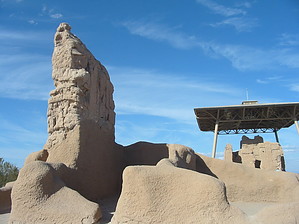| Guide | ♦ | 37 Triplogs | 1 Topic |
details | drive | no permit | forecast | map |
stats |
photos | triplogs | topic | location |
| 171 | 37 | 1 |
Home sweet home by Randal_Schulhauser  History HistoryThe Grand House is a four-story building, as large as a castle and equal to the largest church in these lands of Sonora. Close to this Grand House, there are thirteen smaller houses, somewhat more dilapidated, and the ruins of many others, which make it evident that in ancient times there had been a city here. With these words recorded in his journal in 1694, Father Kino became the first European visitor to these prehistoric ruins. The "Great House" reference or "Casa Grande" in Father Kino's native tongue, lives on today in the National Monument status bestowed upon this site. The frequency of visits by various Spanish expeditions enhanced the mystery as to its origin and meaning. The overland route from Tucson to San Francisco taken by Spanish settlers led by Juan Bautista de Anza rested for a day on October 31st, 1775, near Casa Grande. This allowed Franciscan Friars Font and Garces to explore the site, take measures, and record the intricacies of the architectural design. They dubbed the Casa Grande the "Palace of Montezuma" and concluded the site had been built by the Aztecs.
A tradition of "leaving one's mark" on the ruins was also established, including those by J.W. Ward in 1871. By 1880, the Southern Pacific Rail Road established a station in the town of Casa Grande and a connecting stagecoach route to allow tourists to visit the ruins. Some of the earliest known photographs of the site are from this period. With every tourist visit, there seemed to be fewer ruins as souvenir hunters removed pottery, pieces of wood, and even parts of the walls! In 1892, recognized for its significance as a prehistoric ruin, the site was designated the first archeological preserve in the United States. Efforts to curb vandalism and stop the deterioration of the site commenced. By 1903, the first roof was constructed over the Grand House to combat the effects of sun and weather erosion. Around this time the assumed convention that Casa Grande was Aztec ruins was challenged. Noting many parallels between Zuni ceremonial structures in New Mexico and other southwest archeological finds seemed to change the notion almost overnight. The discovery of this ancient Hohokam culture led to elevating the site to National Monument status in 1918. A series of archeological digs established the existence of "Compound A & B" and in 1932 a new steel and concrete canopy was placed over the ruins. This established the unworldly, distinctive, and iconic appearance seen to this day. Hike Start your hike at the Visitor's Center by paying the $5/person (16+ years of age). Alternatively, use your National Parks Annual Pass to gain "free" admission. Inside is an interpretive display of various artifacts unearthed during the many archeological digs and restoration efforts the past 100+ years. As you exit the Visitor's Center and enter Compound A, you are greeted with a sweeping view of the Great House and its outlying walls and buildings. There's an opportunity for self-guided tours absorbing the factoids and stories parlayed on the many plaques. Or take part in a Volunteer Ranger guided tour to learn even more! Explore the out buildings and speculate on the reasons the Hohokam built and then abandoned this ancient settlement. Walk the perimeter wall of Compound A to gain an appreciation for the size of this settlement. At its zenith around 1300, it's thought that more than a thousand Hohokom people lived near this site. Don't forget Compound B when you finish walking the Great House and central plaza. Located on the north side of the parking lot are a picnic area and some raised viewing platforms. From the raised viewing platforms you will see the remains of two pyramids and a ball-playing court. Walking Compound B is not permitted at the time of this writing due to ongoing archeological investigations. Summary I'm often asked to recommend "family-friendly" hikes. With a personal preference for the strenuous and extreme (think ruins in the Sierra Anchas), this is not a family outing option. Having daughters that consider a walk around the local mall a hike, this relatively short, flat, historical excursion certainly makes for an acceptable compromise. Enjoy! Check out the Triplogs. Leave No Trace and +Add a Triplog after your hike to support this local community. | |||||||||||||||||||||||||||||||||||||||||||||||||||||||||||||||||||||||||||||||||
 Route Editor
Route Editor




